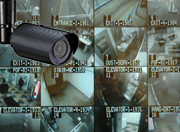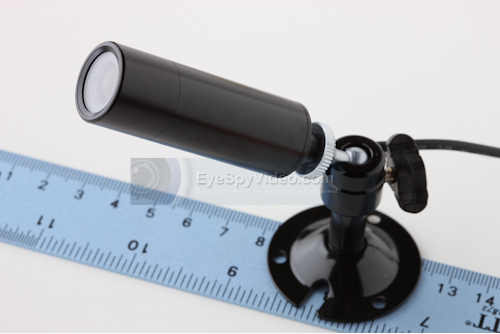Pan Tilt Zoom
1. What is the difference between fixed focus and varifocal / zoom lens type cameras?
2. What does pan / tilt / zoom equipment actually do?
3. What is the difference between digital zoom and optical zoom cameras?
4. Can I obtain panning and tilting ability without using a zoom camera- or vice versa?
5. Do I need to manually control a zoom lens type camera- and how?
6. How can I remotely view or control PTZ camera functions from another location?
7. What is a DC auto iris and why should it be considered?
Q1: What is a varifocal or zoom lens camera?
A1: Fixed lens cameras have a set field of view and cannot be manipulated to produce a wider or narrower angle. These are generally found as 3.6mm, 4.3mm, 8mm, 12mm, etc.. The higher the number of the focal length, the more telephoto the effect. *However- this has nothing to do with the actual size of the lens itself. You can obtain a 3.6mm lens which can range in physical size from 1mm (on a micro pinhole type camera) to the size of a soda can (for much larger security type cameras).
Variable focus (or varifocal) lens cameras allow the user to modify the field of view from its widest/ most panoramic to the narrowest and most telephoto views that it is capable of. Some lenses provide a 4-8mm (widest at 4mm and most telephoto at 8mm)- whereas others may provide 5-50mm for a super zoom in ability.
Many are set up to interface with a variety of optional lenses. However, there are also cameras with built-in lenses that cannot be removed or replaced. The removable type mounts are referred to as "C" or "CS" mount because of the type/ size which is an industry standard. Many lens choices are available and the decision should be based on actual requirements for the application. For instance, if a wide field of view is required, there may be no reason to include a feature which allows a zoom to a tighter shot.
It should be noted that most varifocal cameras are not weatherproof and will require a suitable enclosure for outdoor use. However, we do carry these outdoor housings, including those with built-in heater/ blower. Also, we have an incredible weatherproof integrated PTZ camera available (DN-PTZ) which allows you to facilitate pan, tilt and zoom functions all from a SINGLE control- with all parts protected inside a weatherproof dome with thermostat controlled heater/ blower inside!
Back to top-->
Q2: What does PTZ or pan / tilt / zoom equipment actually do?
A2: This can be a big point of confusion as many people tend to group this type of camera into a single category when there are actually a wide spectrum of features, abilities, options, and performance issues to consider. Some are faster than others- some are more compatible with certain external equipment. Panning is simply the ability to go from side to side and tilting the ability to go up and down. PAN & TILT are both accomplished by some type of external motor, while the zoom function (whether manual or remote) is inside the camera or lens itself. We do carry different cameras that integrate ALL 3 functions (pan, tilt and zoom) into a single control- in both indoor and outdoor versions.
Weatherproof PTZ equipment can be rather expensive. Even decent quality pan/ tilt housings designed for actual outdoor use are very expensive- and don't even include a the camera or camera housing. We offer a unique solution to this problem. It's a special PTZ outdoor spherical dome system with a 220x zoom (22x optical, 10x digital) with a Sony G5 chip that is the best we've ever seen- and at a price that is actually affordable to most security budgets! Please click here to see our integrated Pan / Tilt / Zoom weatherproof dome camera (DN-PTZ).
Back to top-->
Q3: What is the difference between 'digital zoom' and 'optical zoom'?
A3: Optical zoom is the traditional method of physically manipulating the distance between 2 lenses to create a different camera view. Digital zooming is a technique in which an electronic processor literally magnifies size of the pixels imaged by an optical lens. There are different techniques, but "grainy" appearance is typically associated with digital zoom, especially when the camera. Of cameras that have the ability to zoom (aka varifocal lens cameras), some are optical, some are digital- and some are both (such as our TV-C270)- which means that the mechanical lens movement and internal digital magnification are both taking place (22x optical and 10x digital = total 220x zoom capability). It should be noted that not all digital zooming technology is the same. We've seen all ranges from extremely poor to excellent and are quite pleased with the equipment we carry. Back to top-->
Q4: Can I pan & tilt without a zoom camera- or vice versa?
A4: Absolutely. In fact, many systems referred to as PTZ are actually the combination of a pan - tilt housing with the addition of zoom camera. However, there are also truly integrated PTZ systems in which the user can choose one or all functions. Back to top-->
Q5: Do I need to manually control a zoom lens type camera- and how?
A5: It all depends on the camera. Most variable focal (varifocal) "zoom" lens cameras actually do require the user to set the optimum adjustments by hand. Some zoom cameras, like our TV-C270, have the ability to control the zoom and focus the camera with a wired remote controller from 125' away. The TV-C270 camera is ALSO available integrated into a pan/ tilt unit to control all functions with a SINGLE REMOTE! Also see our DN-PTZ, which is A FULLY INTEGRATED PAN/ TILT & POWER ZOOM CAMERA in a compact, attractive weatherproof dome (complete with thermostatically controlled heater/ blower built in). Back to top-->
Q6: How can I remotely view or control PTZ camera functions from another location?
A6: Remotely viewing one or many cameras over is not a huge challenge. However, remotely controlling functions of specialized camera is where it can get tricky. The problems are generally the result of incompatible equipment. If the internal software protocols of the site driver are not recognizable to the camera- or vice versa- the result will be a functional camera with no ability to function. This is a strong warning of why it is necessary to do your homework before designing or purchasing any type of complex equipment. Again, as with most things- there are a wide variety of products out there to suit a variety of needs. Please contact us for specific or advanced PTZ issues. Back to top-->
Q7: What is a DC auto iris and why should it be considered?
A7: A DC powered "auto iris" function is basically used to regulate the amount of light entering the camera in different lighting conditions. They are often used to amplify light for a lens to obtain a more defined picture view for the camera. Use of such a camera and lens outfit can dramatically improve performance in lower lux conditions. You can often spot such a setup by seeing a cord between the back of the camera body and the lens itself. It is there to provide a means to deliver the DC voltage from. You cannot simply attach such a lens to any camera- even if the mount is a perfect fit. DC auto iris lenses require voltage and, therefore, a camera with a compatible DC auto iris output port. This is why it is recommended that you purchase a lens and camera together from the same company. Back to top-->


 Cart is empty
Cart is empty
 Help
Help

